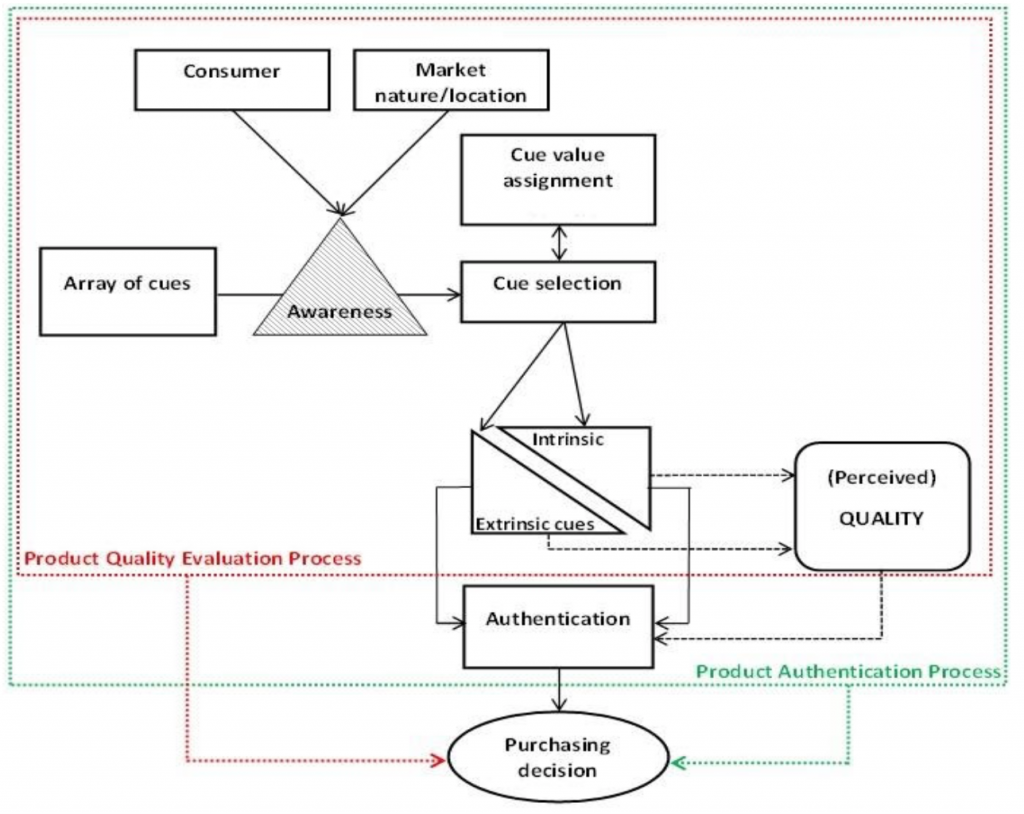Zoltan-Levente Fejes and Jeremy Wilson, 2013
The proliferation of counterfeit goods has made product authentication increasingly important, with consumers and end users playing greater roles in the authentication process. Determining the degree to which infringing products can deceive customers is crucial for assessing the economic and public health and safety impact of counterfeiting and piracy, and for developing appropriate and effective countermeasures. Recent proposals to criminalize counterfeit purchase as a means of fighting counterfeit trade have also rekindled interest in understanding authentication of products. Yet research on how consumers differentiate between genuine and fake is lacking. We have developed a theoretical framework to guide future research on the effect of consumer characteristics, product attributes, context, and market characteristics on product authentication, as well as on the importance of specific intrinsic and extrinsic product cues, outlining several policy implications. This Backgrounder summarizes key issues contained in our full study, which was published in the International Journal of Comparative and Applied Criminal Justice.
Introduction
In the context of product counterfeiting we generally consider consumers as victims that need to be protected from deceit, economic loss, and potential health hazard. We may also think of them as a driving force for counterfeit trade, who, as users, (knowingly or unknowingly) fuel the demand for counterfeit products. But we often fail to think of them as guardians, (active) product authenticators that represent “the last line of defense” against counterfeits.
Some scholars have argued that with the improvement in quality of counterfeit products in recent years, the ability of consumers to distinguish fakes from genuine items has diminished and so did their role as guardians or product authenticators. Others claim that if consumers weren’t purchasing counterfeit products, counterfeiting would cease to be problem altogether, and that the supply of counterfeit products will exist as long as there is a demand for them.
We disagree with such assessments. While all those buying counterfeit goods undoubtedly fuel the demand for them, not all consumers purchase them intentionally or knowingly. Furthermore, some consumers make an effort to protect themselves against deception and financial loss through their own process of product authentication.
Our recent research examined the literature on consumer authentication and cue utilization in product evaluation. We sought to answer such questions as how do consumers differentiate between genuine and counterfeit products? What heuristics do they use in the process of authentication? What factors affect this process and how? Starting with Staake et al.’s (2009) rigorous review of the product counterfeiting literature, we conducted our review in four distinct phases. In the first phase, we systematically reviewed and analyzed 47 publications identified as “demand-side” investigations. Second, we used an open-source search process to identify additional relevant peer-reviewed journal articles and other scholarly publications. Third, we conducted a “snowball” search process based on the references of identified publications. Fourth, we critically reviewed all 77 relevant publications we ultimately identified.
Main Findings
The studies we reviewed suggest that consumers use both intrinsic (tangible physical and performance attributes) and extrinsic (attributes external to the product) cues to authenticate a product. In other words, buyers recognize that a product is not authentic according to specific informational cues associated with it such as: price; purchase location; the arrangement and the type or nature of the sales outlet; poor packaging and printing; product quality; brand and store name, as well as retailer reputation. More intricate cues (e.g. product quality) require prior knowledge and experience of the consumer.
Although these are important findings, these studies (N=5) have several significant limitations. They typically assess behavior of students who, while active purchasers, represent only a small fraction of all consumers. Similarly, the focus on a small number of cues (and a limited array of products), the failure to explore composite effects of product cues on the process of product authentication, the failure to address the mediating or interactive effects of product cues on each other, and the exclusive attention to non-deceptive counterfeits constitute further limitations that hinder the understanding of this complex process.
Previous research also has not clearly delineated a theoretical framework. Five exploratory studies address the issue of cue utilization by consumers in product authentication but do not develop a theoretical model that would explain which cues consumers select nor how and why they use them in product authentication. To address this issue, we have developed a comprehensive theoretical framework regarding the nature of the consumer authentication process and the utilization of product cues, and that can serve as a basis for future research as well as for policy decisions.
The Cue Utilization in Consumer Product Authentication Framework
Our framework has three basic assumptions: that, in general, genuine products will be of higher quality than counterfeits; consumers seek to purchase genuine products at a reasonable price; and product evaluation is a rational behavior. The consumer product authentication process we describe is a complex process influenced by many variables and characterized by an intricate relationship among them. It is a highly subjective process that may produce inconsistent results. Figure 1 provides a somewhat simplistic visual depiction of the process.
Our framework shows consumers relying on cues to evaluate product quality and authenticity. They engage in the authentication process if there is an indication the product may be fraudulent. Thus, awareness of consumers regarding counterfeits and product cues is crucial to the authentication process, because such awareness is necessary to initiate the process and shapes the pool of cues available to consumers for selection and use. Consumers select cues based on the beliefs they have in their efficacy in determining authenticity, their familiarity with genuine product attributes, their purchasing behavior, and their motivation to purchase. The type of product under investigation, the location of the market, beliefs about the market, and arrangement or type of the retail outlet will also impact cue selection and the authentication process.

Figure 1: Cue Utilization Framework
After selecting intrinsic and extrinsic cues, consumers must compare them to a benchmark, contrasting the evaluated product to (an already authenticated) genuine product or to a mental image and determining whether the evaluated product is genuine or not. Because the predictive value of a cue or a cue cluster may significantly affect when an evaluation must rely only on memory of a genuine product, consumers may not always produce reliable or replicable results. Because the process of differentiation is not infallible, consumers may miscategorize the product or not be able to determine whether it is genuine or counterfeit. If consumers cannot determine whether a product is genuine or counterfeit, they will search for more clues, refrain from purchase, or proceed in spite of failure to authenticate. A decision to proceed in spite of failure to authenticate would depend on the consumer’s attitude towards counterfeiting, the willingness to purchase counterfeits, and the motivation to purchase.
Future Research and Policy Implications
We aimed to create a conceptual framework that would describe cue utilization by consumers in product authentication. We sought to organize scientific thinking, connect sparse research efforts that have addressed this issue, and outline a research agenda for a more comprehensive understanding of the phenomenon. Because research on consumer differentiation between genuine and fake is lacking in many aspects, future research should examine the effect of consumer characteristics, product attributes, context and market characteristics on product authentication, as well as the relative importance of specific intrinsic and extrinsic product cues in product authentication.
Our framework provides knowledge that goes beyond creating an opportunity for scholars to build on it and develop a better understanding of consumer involvement and the variables in the consumer product authentication process. Policy initiatives to curb counterfeit trade by targeting consumption of counterfeit goods, as well as other private and public countermeasures, can also benefit from the holistic understanding of product counterfeiting. Such policies will also require criminal-justice practitioners to possess the type of knowledge and understanding that our study provides.
Knowledge from our framework, combined with findings from the limited but important research that has addressed the issue, may lead industry to adjust their manufacturing, marketing, and retailing strategies to account for cues consumers use in product authentication. Such changes can facilitate the differentiation between genuine and counterfeit products. Information on consumers’ cue seeking and selection behavior may lead to the development of more efficient strategies for raising the awareness of consumers regarding counterfeit merchandise, and for informing and educating them about fraudulent-good detection. Education regarding genuine product features may also empower consumers and reduce the possibility of victimization.
Customs and other enforcement agents may also use cues similar to those that ordinary consumers do in differentiating authentic and fake products. Therefore, knowledge from our framework may also enhance criminal-justice training programs, improve enforcement efforts, and decrease the effect of counterfeit products on the economy and public health.
For more information, please refer to our full study: Fejes, Zoltán-Levente, & Wilson, Jeremy M. “Cue Utilization in the Consumer Authentication Process: A Framework and Research Agenda.” International Journal of Comparative and Applied Criminal Justice, iFirst, 2012, 1–24
2013 Copyright Michigan State University Board of Trustees.
